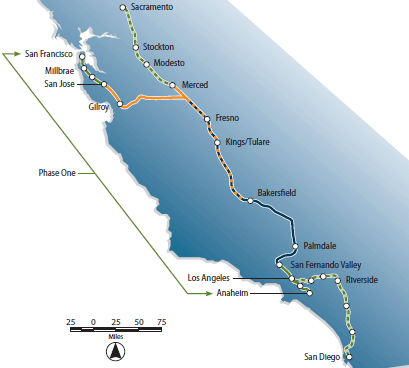It started out benign enough. In November 2008, California voters passed Proposition 1A, which authorized the issuance of $9.95 billion in general obligation bonds to fund the first stage of a high-speed rail link between Los Angeles and San Francisco, with extensions to San Diego and Sacramento. The project would cost $35.7 billion. The federal government would pick up a chunk. And it would be profitable.
High-speed rail works if it links big urban areas, has lots of riders, and covers medium distances so that travel times are shorter than driving or flying. The most successful is the Shinkansen between Tokyo and Osaka, which transports 150 million passengers per year. Even Amtrak’s slower route between New York City and Washington DC is profitable, though the rest of Amtrak is not.
In theory, California’s project falls into that category. In theory—because in reality, it’s already mucked up. And now, we even have to listen to radio spots by the California Alliance for Jobs, which represents construction contractors and unions, the recipients of the forthcoming flood of taxpayer money. The spots are trying to bamboozle us, the restive people, into overlooking the nightmarish problems of the project.
In three years, the budget for phase one has nearly tripled to $98.5 billion—though construction hasn’t even started yet. This came out last November when the California High-Speed Rail Authority (CHSRA) published an updated Draft Business Plan.
Nay, it has more than tripled to $117.6 billion. The $98.5 billion that has been bandied about in public is the low end of the estimate. Over 100 pages into the business plan, on page 8 – 2, we find the high end: $117.6 billion.
The business plan was part of the formal request to the Legislature for $2.7 billion, the first tranche of the Prop 1A bond money. It would be matched by $3.5 billion in federal money and would be plowed into building the initial section—130 miles of track in the Central Valley from just north of Fresno down to Bakersfield. It would lack electrification and high-speed-train control and communication systems. Hence, only regular diesel trains could use it.
Then on January 3, the California High-Speed Rail Peer Review Group sent a letter to the Legislature, recommending that the project be put on hold for a variety of reasons, particularly funding. Only $12.5 billion have been secured. But if future funding doesn’t miraculously materialize, that initial section in the Central Valley will become an icon of high-cost rail from nowhere to nowhere.
But even $117.6 billion might not be enough. January 24, State Auditor Elaine Howle issued her audit report of the CHSRA (Fact Sheet, Full Report). Turns out, the business plan left out the nominal sum of $97 billion in operating and maintenance costs from 2025 to 2060. Oops. The plan says that revenues would cover all such costs starting 2022, the year trains are projected to roll on the initial section. What if revenues fall short? Is anyone going to take a diesel train from Bakersfield to Fresno? Elegantly, no operating losses are figured into the plan. And if there are losses, funding requirements would jump.
The business plan “assumes that federal funds must cover 80 percent” of the cost, according to the audit report. Highways might receive that level of federal funding via the Highway Trust Fund. But Congress is considering legislation to would make it impossible for highway funds to be used for the California High-Speed Rail project. And the general fund? Good luck! Maybe the CHSRA should form a bank holding company; the Fed is handing them money for free.
And then, there’s San Francisco to Sacramento. To avoid having to cross the Bay, the ingenious plan turns the 87-mile drive into a whopping 300-mile train ride. I mean, come on. No one will use it. It’s a joke.
From the Draft Business Plan
And now we learn, to top it off, if that were even possible, that the CHSRA paid taxpayer money to Ogilvy Public Relations Worldwide to lobby the Legislature to get more taxpayer money—the $2.7 billion mentioned above.
“It just doesn’t pass the smell test,” said Assemblyman Jerry Hill, D-San Mateo.
All that, while California is broke again. Out-of-money date is March 8. $3.3 billion must be dug up, pronto. Ha!
Enjoy reading WOLF STREET and want to support it? You can donate. I appreciate it immensely. Click on the mug to find out how:
![]()


